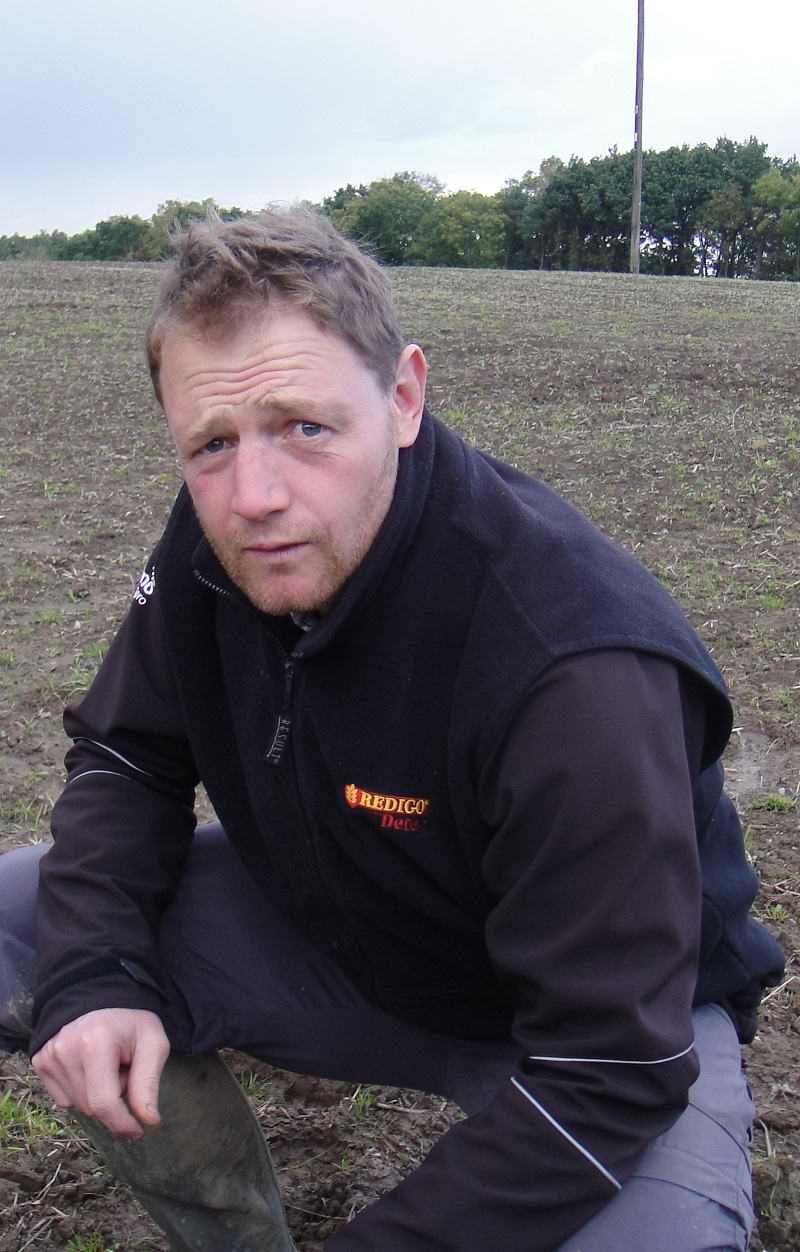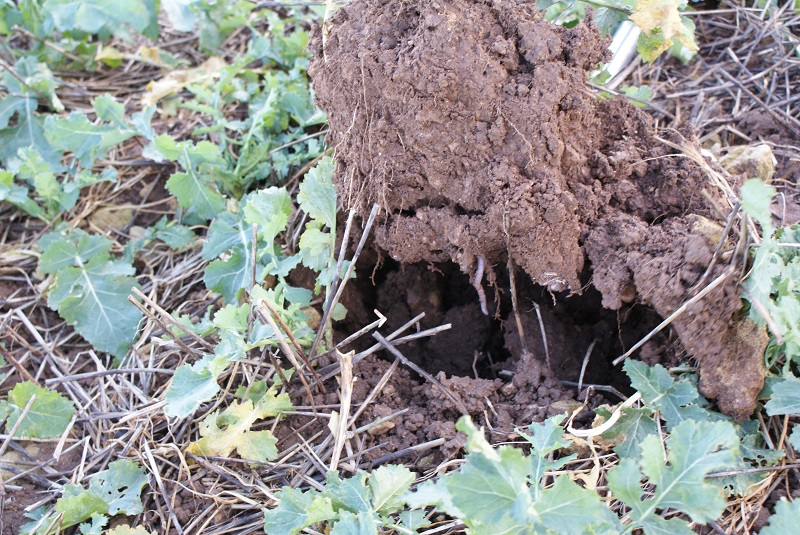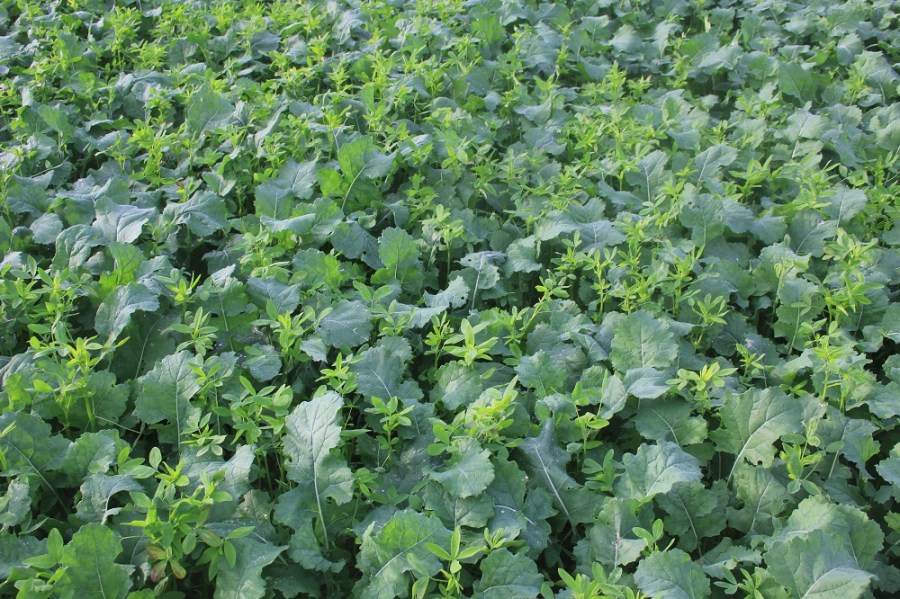 The past few years have seen huge developments in cover and companion cropping to help with weed control, soil improvement, nutrition and other holistic agronomic factors. Agrovista’s research and development has looked at how these types of crops can help in commercial situations to solve some of the issues faced by growers today.
The past few years have seen huge developments in cover and companion cropping to help with weed control, soil improvement, nutrition and other holistic agronomic factors. Agrovista’s research and development has looked at how these types of crops can help in commercial situations to solve some of the issues faced by growers today.
Planting a companion crop alongside oilseed rape brings considerable benefits to the soil as well as enhancing the yield of the crop. CPM finds out more from Agrovista’s Chris Martin.
A companion crop can mean the difference between OSR establishing well and crop failure.
By Lucy de la Pasture
Most soils are experiencing a particularly difficult year after high levels of rainfall and little frost. As a result, areas where there’s any soil damage or compaction are already showing up in some fields. That means repairing the soil will be top of the list looking forward towards the autumn and the roots of berseem clover, in particular, may offer a growing solution to a difficult problem.
In France, companion cropping has been proven to deliver considerable benefits to growers, including reduced impact from pests and weeds. Agrovista has spent four years looking at whether the same benefits apply under UK conditions.
What are companion crops?
Companion cropping involves sowing two crops alongside one another, with the aim that the companion helps the main crop to thrive.
The idea is that the companion plants essentially ‘harvest’ sunlight, which would otherwise be wasted, and convert it into organic matter. As growing plants, they also mop up any excess nutrients which reduces soil losses over the winter months.
Depending on the species used as a companion, plants either die off under winter conditions or are destroyed. When companion plants die, the surrounding crop is able to utilize nutrients they release as they break down. Berseem clover has the added benefit of being an extremely good soil aerator and conditioner, to the extent that it’ll practically do the subsoiling for the grower.
How does it help OSR?
A key Agrovista finding is that a companion crop can mean the difference between OSR establishing well and crop failure and generally improves establishment.
Slug damage has been notably less where a companion crop is planted, though the reason for this isn’t completely understood. On the continent, flea beetle incidence is said to be reduced but this isn’t something that Agrovista has been able to substantiate in their trials programme. What they did find was fewer larvae/plant, but because of better OSR establishment, the number of larvae/m² was the same as in a conventionally sown crop.
Oilseed rape is a notorious lazy rooter so the companion crop acts as a pathfinder for the roots of OSR plants, increasing root biomass by 20%. Since there’s almost a linear relationship between yield and root biomass, yield responds accordingly.
Why is C:N ratio important?
Carbon:nitrogen, or C:N ratio, is a measure that roughly reflects the amount of woody material to green, soft plant tissue. As a rule of thumb, the smaller the C:N ratio is, the more rapidly plant material will decompose. This has a direct relationship with the amount of nitrogen that’s tied up in the soil that’ll be available to the next growing plant.
The reason it takes longer for the higher C:N ratio residue to decompose is because soil microbes have to pull available nitrogen from the soil to reach its optimum ratio of approx 24:1. This will lead to the excess nitrogen in the soil to be tied up and may lead to a deficit until some microbes die and release the nitrogen or other sources of nitrogen are provided.
Berseem clover and vetches have a low C:N ratio that means that it decomposes relatively quickly, releasing nitrogen back in the soil for the OSR crop to utilise in the spring.
What mixes are best?
Evaluation work by Agrovista indicates berseem clover as the best companion for OSR, either alone or in mixture with vetches. For most situations, berseem clover alone provides an effective companion at a cost of around £10/ha.

Agrovista has spent four years looking at whether companion-crop benefits, proven in France, apply under UK conditions, says Chris Martin.
It’s vital that the correct variety of berseem clover is chosen with no winter hardiness so it’s easily killed under winter conditions, meaning no added cost to remove it.
Vetches are more hardy, dying only after a prolonged period of significant frost (minus 8-10°C), so in most seasons, clopyralid is required for destruction. On the other hand, vetches are better able to capture nitrogen – typically 40kg N /ha, compared to 10-15kg N /ha by the clover.
Ultimately, choice comes down to what you’re aiming to achieve. Berseem clover alone is enough to aid establishment, rooting and release some N. But if nitrogen capture is the prime objective, then the addition of a vetch to the clover is useful.
How does it help the soil?
The biggest benefits from the roots of berseem clover are seen in soils where there’s been little cultivation. Organic matter is returned to the soil and overall soil health improves.

Companion crops with a low C:N ratio decompose quickly, releasing nitrogen back in the soil for the OSR crop to utilise in the spring.
The roots have a jackhammer effect; the long, thin taproot grows straight down in the soil profile and is able to penetrate pans. The taproot doesn’t branch so there’s no lateral compaction of soil around it. The root quickly grows deeper than any agricultural machine can or should work, aerating the soil and creating channels for water to move through the profile.
Mycorrhizal fungi in the soil greatly improve the ability of plants to access soil resources but OSR roots won’t interact with them. Planting berseem clover seed impregnated with mycorrhizae is one way of quickly bringing phosphate into play, which would otherwise be locked up, getting more value out of the soil.
What have trials shown?
Agrovista’s four-year trial programme investigating seed mixtures has led to the successful commercial uptake of berseem clover as a companion crop for OSR. Continuing work on cover crops (including berseem clover and vetches) is focusing on soil health, with the aim of putting tangible figures on their benefits to the soil and to the grower.
Increasing soil organic matter and reducing soil disturbance means a more biologically active soil with a more stable structure. Part of the ongoing work by Agrovista is looking at the performance of berseem clover against a subsoiler and comparing fuel consumption under different tillage approaches. Early indications are there are possibly big savings to be made on fuel by utilizing plants as soil improvers.
What about agronomy?
Berseem clover is a small seed, similar to OSR, and can be planted using any drill on existing row widths. Agrovista advice is for growers to use the same seed rate as for the OSR crop and to mix the two different seeds together in the drill.
Herbicides commonly used in OSR are well tolerated by companion crops with the exception of clomazone, which should be avoided. Astrokerb (aminopyralid+ propyzamide) will take out berseem clover but at the time of use, late Nov/Dec, the clover is likely to die anyway.
Where vetches are included in the mix, Astrokerb will kill the vetches prematurely and because they have a very low C:N ratio, nitrogen would be released quickly at a time when the OSR isn’t growing. Vetches are likely to require application of clopyralid (after March 1) to remove them.
Where nitrogen is applied in the autumn for OSR establishment, companion crops will mop up any that isn’t required by the crop and release it in the spring. They provide a useful insurance policy, especially where OSR is grown in the North.
How about Maize?
Although OSR has the most potential for companion cropping in the UK, there are also benefits with maize. Particularly valuable is when it comes to stabilising stubbles after harvest to prevent run-off and mopping up residual phosphates from slurry and digestate applications.
A natural pan-buster
“A good subsoiler” is how Robert Atkinson describes the berseem clover he uses in cover crop mixes and as a sole companion to oilseed rape on his 180ha farm, to the north of Doncaster.
“If you’ve really abused your soil, then there’s probably no alternative than to use steel,” he says. “But like habitual smokers, most farmers are addicted to deep cultivation because it makes them feel better for a short period of time while ignoring the real damage they’re doing.
“The OSR follows the berseem clover roots down and soils benefit from the increased root systems,” he says. “It makes a really good job of establishing the OSR, leaving ground much more friable and easier to work the following autumn.”
He’s been using both cover crops and companion crops on the farm for a number of years but this is the first year that he’s planted his entire OSR acreage together with a companion.
“In the past, we’ve used both purple and common vetches in the mix but this year we’ve gone for berseem clover alone. It’s a cost-effective option that seems to bring us a host of benefits,” he says, identifying improved OSR establishment and reduced feeding damage from slugs, flea beetle and pigeons.
His farm is split between lighter sandy loams and the heavier clay soil types, preferred by OSR and slugs alike.
“Whether slugs are eating the berseem clover or just don’t like the mix of plants we don’t know but damage seems to be less where it’s planted,” he says. “We’re also finding we have less pigeon damage because there’s such good ground cover, they can’t land in the crop.”
He’s trialled a number of establishment methods and settled with direct drilling using a Moore Unidrill, mixing berseem clover seed with the OSR seed.
“It’s very important not to overfill the drill because the berseem clover seed is about half the size of OSR seed and could potentially settle out towards the bottom of the drill. I’d recommend mixing no more than 2-3 bags at a time,” he suggests.
Getting some seedbed nitrogen on is a must, he believes, to help get both crops going. But in the spring, savings on nitrogen have been the norm, without any reduction in yield.
The unusually warm early winter meant that the clover survived but died off after a planned application of Astrokerb in early Jan. “You don’t want the berseem clover alive any later – the sooner it dies then the sooner nitrogen will become available for the OSR crop.”
Another benefit he’s noted is that berseem clover helps OSR survive in wet soils a lot better. “We’ve trialled it in wet areas of fields and you could see it to the line – the OSR looked much better than where a companion wasn’t planted,” he says. “The roots improve soil drainage, getting water away from the rooting zone, but also works the other way and sucks water out of the soil too.”
Companion crops for OSR: top tips
- Get planted early – companion crops need to be sown with good seed-to-soil contact and get away well.
- Mix seeds in drill – keep things simple, use the same seed rate as OSR and drill together.
- Don’t drill too deep – the shallower the better, although depth will be governed by planned herbicide regime.
Sponsor message
The Growers Choice Insite trials programme, conducted by Agrovista UK, lies at the heart of their success in providing the most up-to-date and unbiased technical information possible.
This information is then utilised on farm to maximise gross margins in a consistent, cost-effective and responsible manner. This in-depth programme is dedicated to finding practical solutions to crop production problems, whether in the broad-acre arable crops or in the pursuit of high-value fruit and vegetable produce.
With a series of fully replicated major trials sites, managed to the highest standard, it constitutes one of the largest independent trials programmes in the UK. These trials protocols not only study the crop protection inputs, but also variety, rotational factors, site class, nutritional regime and how different cultivation techniques affect yield and quality. Furthermore, the trials sites are situated across the country to ensure that local climatic conditions – as well as various soil types – are taken into account.




